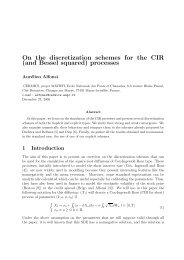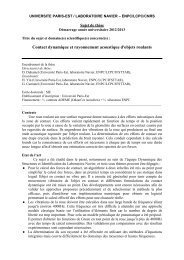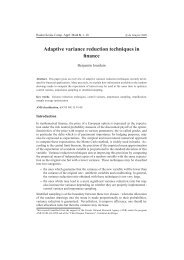The geography of inequalities in Europe Philippe Martin ... - ENPC
The geography of inequalities in Europe Philippe Martin ... - ENPC
The geography of inequalities in Europe Philippe Martin ... - ENPC
Create successful ePaper yourself
Turn your PDF publications into a flip-book with our unique Google optimized e-Paper software.
though it may not be the most efficient way to do this. Work by Duranton and Monastiriotis(2002) and Gobillon (2002) however suggest that this is only partially the case. <strong>The</strong> first paperuses data on average regional earn<strong>in</strong>gs <strong>in</strong> UK dur<strong>in</strong>g the 1982-1997 period. It shows a worsen<strong>in</strong>g<strong>of</strong> UK regional <strong><strong>in</strong>equalities</strong> and a rise <strong>in</strong> the North-South gap. However, differences <strong>in</strong> educationaccount for most <strong>of</strong> the aggregate divergence. London ga<strong>in</strong>ed because its workforce becamerelatively more educated over the period. Second, returns to education <strong>in</strong>creased nation-wide,which favoured the most educated regions (i.e., London). Third, returns to education were<strong>in</strong>itially lower <strong>in</strong> London but they (partially) caught up with the rest <strong>of</strong> the country. Had returnsto education and their distribution across UK regions rema<strong>in</strong>ed stable over the period, the UKNorth-South divide would have decreased.Gobillon (2002) uses <strong>in</strong>dividual French data on wages to quantify the determ<strong>in</strong>ants <strong>of</strong>local disparities <strong>in</strong> wages dur<strong>in</strong>g the 1978-1990 period. He f<strong>in</strong>ds that two thirds <strong>of</strong> regional<strong><strong>in</strong>equalities</strong> <strong>in</strong> wages is expla<strong>in</strong>ed by the <strong>in</strong>dividual characteristics <strong>of</strong> the workers; <strong>in</strong> particularhis or her level <strong>of</strong> education. Of course this leaves one third unexpla<strong>in</strong>ed but this is the maximumthat geographical factors could account for.<strong>The</strong>se two studies suggest that a major reason for the <strong>in</strong>crease <strong>in</strong> regional <strong><strong>in</strong>equalities</strong><strong>in</strong>side <strong>Europe</strong>an countries may not have much to do with <strong>geography</strong> <strong>of</strong> production per se. Ifreturns to education have <strong>in</strong>creased s<strong>in</strong>ce the 1980s, which most labour economists believe, thenthe <strong>in</strong>crease <strong>in</strong> regional <strong>in</strong>equality is at least partially a consequence <strong>of</strong> the <strong>in</strong>crease <strong>in</strong> <strong>in</strong>dividual<strong><strong>in</strong>equalities</strong> itself caused by the <strong>in</strong>crease <strong>in</strong> the return to education. A plausible story is that<strong>in</strong>itially rich regions were well endowed with workers with high levels <strong>of</strong> education so that the<strong>in</strong>crease <strong>in</strong> regional disparities <strong>in</strong> GDP per capita reflected the association <strong>of</strong> a general <strong>in</strong>crease<strong>in</strong> the return to education and the <strong>in</strong>itial geographical disparity <strong>in</strong> education levels. Furthermore,it is well known that better educated workers are more mobile so that they may haveconcentrated <strong>in</strong> the richer regions too.Can regional policies <strong>in</strong>crease social <strong><strong>in</strong>equalities</strong>?<strong>The</strong> type <strong>of</strong> <strong>in</strong>strument used by regional policies also has important implications for thel<strong>in</strong>k between <strong>in</strong>dividual <strong><strong>in</strong>equalities</strong> and regional <strong><strong>in</strong>equalities</strong>. Most countries subsidize<strong>in</strong>vestment rather than employment at the regional level and this translates <strong>in</strong>to subsidies tocapital rather than labor (see Yuill et al, 1997, and Fuest and Huber, 2000). An important
















